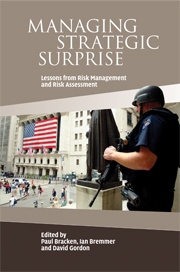Book contents
- Frontmatter
- Contents
- List of figures
- List of tables
- List of contributors
- Acknowledgements
- 1 Introduction
- 2 How to build a warning system
- 3 Intelligence management as risk management: the case of surprise attack
- 4 Nuclear proliferation epidemiology: uncertainty, surprise, and risk management
- 5 Precaution against terrorism
- 6 Defense planning and risk management in the presence of deep uncertainty
- 7 Managing energy security risks in a changing world
- 8 What markets miss: political stability frameworks and country risk
- 9 The risk of failed-state contagion
- 10 Conclusion: managing strategic surprise
- Index
9 - The risk of failed-state contagion
Published online by Cambridge University Press: 14 May 2010
- Frontmatter
- Contents
- List of figures
- List of tables
- List of contributors
- Acknowledgements
- 1 Introduction
- 2 How to build a warning system
- 3 Intelligence management as risk management: the case of surprise attack
- 4 Nuclear proliferation epidemiology: uncertainty, surprise, and risk management
- 5 Precaution against terrorism
- 6 Defense planning and risk management in the presence of deep uncertainty
- 7 Managing energy security risks in a changing world
- 8 What markets miss: political stability frameworks and country risk
- 9 The risk of failed-state contagion
- 10 Conclusion: managing strategic surprise
- Index
Summary
The tremendous humanitarian challenges caused by failed states is now clear. In Somalia, Democratic Republic of Congo, Sierra Leone and elsewhere, when the state's basic institutions collapse, there is almost invariably widespread violence that results in the deaths of tens of thousands, the mass movement of people and significant deterioration of the environment. To date, the international community has largely failed to develop the mechanisms necessary to keep states from failing, largely because state collapse is usually due to powerful social forces that cannot be deflected by the last-minute interventions of others.
As a result, attention has increasingly been focused on preventing one failed state from infecting others. Understanding the actual risks posed by a failed state to its neighbors is the focus of this chapter. The original goal at the outset of this study was to examine the concept of state-failure contagion within the context of epidemiological models to see what, if any, lessons could be drawn from approaches used to stem the spread of infectious disease and applied to the spread of state failure. It soon became evident, however, that this analogy is misleading.
This chapter argues that state-failure contagion is actually a rare phenomenon. There are relatively few examples of when state failure has spread across borders. The vectors that are presumed to carry state failure are actually more complicated, and generally not as potent, as commonly assumed.
- Type
- Chapter
- Information
- Managing Strategic SurpriseLessons from Risk Management and Risk Assessment, pp. 287 - 301Publisher: Cambridge University PressPrint publication year: 2008



